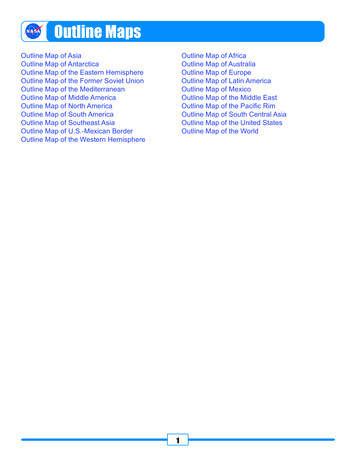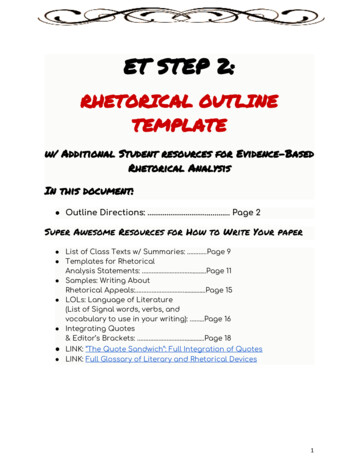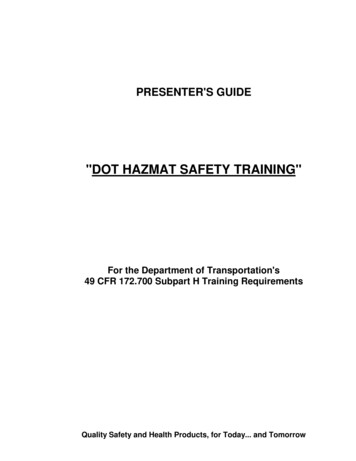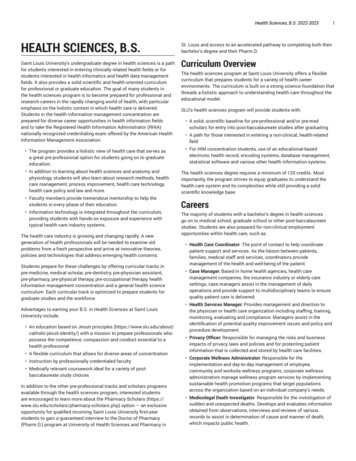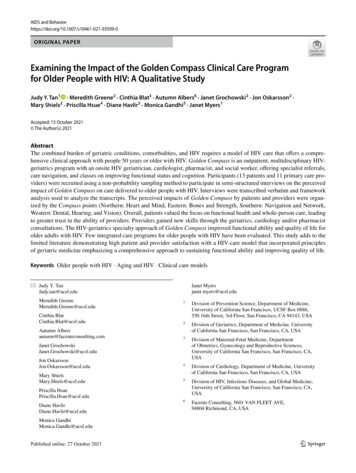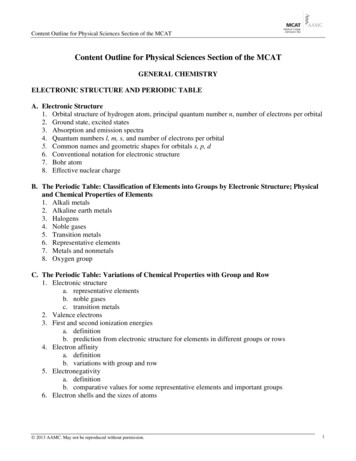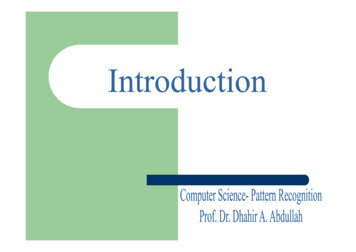
Transcription
OUTLINECourse description,What is pattern recognition,Cost of error,Decision boundaries,The desgin cycle
Course descriptionThe objective of the course is to makestudent familiar with general approachessuch as–––––Bayes classification,discriminant functions,decision trees,nearest neighbor rule,neural networks for pattern recognition.
Course descriptionCourse Book:–R.O. Duda, P.E. Hart, andD.G. Stork, PatternClassification, New York:John Wiley, 2001,
Course descriptionWEEKLY SCHEDULE AND PRE-STUDY PAGESWeekTopicsPre-study Pages1IntroductionChapter 1 (main text)2Bayesian Decision TheoryChapter 23Bayesian Decision TheoryChapter 24Bayesian Decision TheoryChapter 25Maximum – Likelihood and Bayesian Parameter EstimationChapter 36Maximum – Likelihood and Bayesian Parameter EstimationChapter 37Nonparametric TechniquesChapter 48Nonparametric TechniquesChapter 49Linear Discriminant FunctionsChapter 510Linear Discriminant FunctionsChapter 511Multilayer Neural NetworksChapter 612Nonmetric MethodsChapter 813Unsupervised Learning and ClusteringChapter 1014Unsupervised Learning and ClusteringChapter 10
Course descriptionEVALUATION SYSTEMIN-TERM STUDIESQUANTITYPERCENTAGEMid-terms22x25 50150AssignmentFinal ExamTOTAL100
What is a pattern ?an entity, vaguelygiven a name,e.g.:–––––fingerprint image,handwritten word,human face,speech signal,DNA sequence,defined, that could be
What is pattern recognition ?a discipline which learn some theories andmethods to design machines that canrecognize patterns in noisy data orcomplex environment (Srihari,Govindaraju).
What is pattern recognition ?a scientific discipline whose aim is theclassification of the objects into a lot ofcategories or classes. Pattern recognition isalso a integral part in most machineintelligence system built for decisionmaking (Sergios Theodoridis).
What is pattern recognition ?the act of taking in raw data and making anaction based on the category of thepattern (Duda and Hart)
What is pattern recognition ?Pattern recognition is the study of howmachines can:–––observe the environment,learn to distinguish patterns of interest,make sound and reasonable decisions about thecategories of the patterns.
What is pattern recognition ?Some Applications:
What is pattern recognition ?Some Applications:
What is pattern recognition ?Some Applications:
What is pattern recognition ?Some Applications:
What is pattern recognition ?Some Applications:
What is pattern recognition ?Some Applications:
An ExampleSuppose that:––A fish packing plant wantsto automate the processof sorting incoming fish ona conveyor belt accordingto species,There are two species:Sea bass,Salmon.
An ExampleHow to distinguish one specie from theother ? (length, width, weight, number andshape of fins, tail shape,etc.)
An ExampleSuppose somebody at the fish plant say usthat:–Sea bass is generally longer than a salmonThen our models for the fish:–Sea bass have some typical length, and this isgreater than that for salmon.
An ExampleThen length becomes a feature,We might attempt to classify the fish byseeing whether or not the length of a fishexceeds some critical value (thresholdvalue) l*.
An ExampleHow to desie on the critical value(threshold value) ?
An ExampleHow to desie on the critical value(threshold value) ?–––We could obtain some training samples ofdifferent types of fish,make length measurements,Inspect the results.
An ExampleMeasurement results on the trainingsample related to two species.
An ExampleCan we reliably seperate sea bass fromsalmon by using length as a feature ?Remember ourmodel:–Sea basshave sometypical length,and this isgreater thanthat forsalmon.
An ExampleFrom histogram we can see that singlecriteria is quite poor.
An ExampleIt is obvious that length is not a goodfeature.What we can do to seperate sea bassfrom salmon?
An ExampleWhat we can do to seperate sea bassfrom salmon?Try another feature:–average lightness of the fish scales.
An ExampleCan we reliably seperate sea bass fromsalmon by using lightness as a feature ?
An ExampleLighness is better than length as a featurebut again there are some problems.
An ExampleSuppose we also know that:–Sea bass are typically wider than salmon.We can use more than one feature for ourdecision:–Lightness (x1) and width (x2)
An ExampleEach fish is now a point in two dimension.–Lightness (x1) and width (x2)
An ExampleEach fish is now a point in two dimension.–Lightness (x1) and width (x2)
An ExampleEach fish is now a point in two dimension.–Lightness (x1) and width (x2)
Cost of errorCost of different errors must beconsidered when making decisions,We try to make a decision rule so as tominimize such a cost,This is the central task of decision theory.
Cost of errorFor example, if the fish packing companyknows that:––Customers who buy salmon will object if theysee sea bass in their cans.Customers who buy sea bass will not beunhappy if they occasionally see someexpensive salmon in their cans.
Decision boundariesWe can perform better if we use morecomplex decision boundaries.
Decision boundariesThere is a trade of between complexity ofthe decision rules and their performancesto unknown samples.Generalization: The ability of the classifierto produce correct results on novelpatterns.Simplify the decision boundary!
The design cycle
The design cycleCollect data:–Collect train and test dataChoose features:–––––Domain dependence and prior information,Computational cost and feasibility,Discriminative features,Invariant features with respect to translation, rotation andscale,Robust features with respect to occlusion, distortion,deformation, and variations in environment.
The design cycleChoose model:–Types of models: templates, decision-theoreticor statistical, syntactic or structural, neural, andhybrid.Train classifier:–learn the rule from data,Evaluate classifier:––estimate the performanceproblems of overfitting and generalization.
ReferencesSrihari, S.N., Covindaraju, Pattern recognition, Chapman &Hall, London, 1034-1041, 1993,Sergios Theodoridis, Konstantinos Koutroumbas , pattern recognition , Pattern Recognition,Elsevier(USA)) ,1982R.O. Duda, P.E. Hart, and D.G. Stork, Pattern Classification, New York: John Wiley, 2001,
pattern(Duda and Hart) What is pattern recognition ? Pattern recognition is the study of how machines can: . R.O.Duda, P.E. Hart, and D.G. Stork, Pattern Classification, New York: John Wiley, 2001, Created Date: 1/8/2017 6:27:18 AM .
